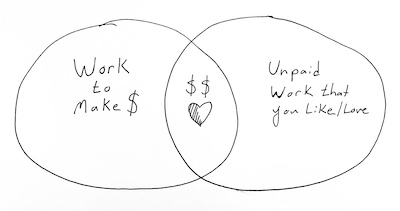Don’t Get Stuck

IN A LECTURE at the California Academy of Arts (CCA) in 2011, both illustrators Jillian Tamaki1 and Sam Weber2 presented a Venn diagram to the audience. I was in the small auditorium, which was full of people. I don’t remember if they showed the diagram or merely described it. The diagram is so simple it can be conveyed either way.

If we glance at the diagram, we might be drawn to the central message: “Make money doing what we love!” However, discerning exactly what that work entails or how to monetize it can be elusive. In contrast, identifying work on the left and right tends to be more straightforward.
The diagram’s guidance is as follows: To find the middle, we must consistently balance between work that pays and the unpaid work we are passionate about. This middle ground is achieved through a back-and-forth process. The risk lies in lingering too long on one side.
In San Francisco, there are a fair number of people who have jobs that pay well, offer great benefits, and, more or less, provide a positive work environment. This situation is often referred to as the ‘golden handcuffs’—enticing incentives that prevent people from finding that middle ground.
As I was writing this piece, I came across an example of the mindset we could adopt. In Haruki Murakami’s latest book, “Killing Commendatore”, the main character decides the following3:
“Since it was impossible to make a living painting what I wanted, once I graduated, I started taking commissions for portraits to make ends meet… They were looking for a realistic, dignifed, staid style, totally utiliarian types of paintings to be hung on the wall in a reception area or a company president’s office. In other words, my job compelled me to paint paintings that ran totally counter to my artistic aims… I made plenty for a young, single man to live on… Several years went by, and I decided that I’d focus on portrait painting for a fixed period, and then, once I’d made enough to live on for a while, I’d return to the kind of paintings I really wanted to do. Portraits were just meant to pay the rent.” - Killing Commendatore by Haruki Murakami, p12-13
So, don’t get stuck on one side.
-
Jillian Tamaki: www.jilliantamaki.com ↩︎
-
Sam Weber: www.sampaints.com ↩︎
-
New York Times In Haruki Murakami’s New Novel, a Painter’s Inspiration Is Supernatural ↩︎
